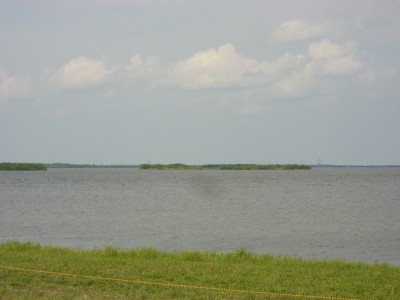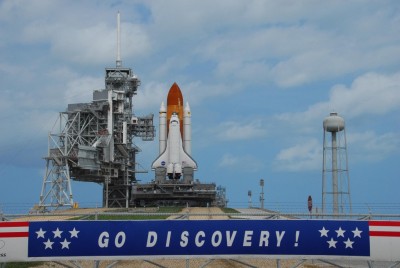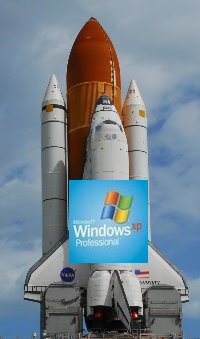 Well … if there are really no tickets available, then you are out of luck. But there are always some tickets left! Here is the story.
Well … if there are really no tickets available, then you are out of luck. But there are always some tickets left! Here is the story.
If you go to Kennedy Space Center to view a launch, you will of course try to get the best viewing spot. That, without question, is NASA Causeway. The causeway is just six miles away from launch pad 39A and the closest place you can get to it without being a NASA invited guest. The picture above was taken from the NASA Causeway viewing site in summer 2006. It is taken without a zoom lens and resembles what you can see with the naked eye. Hazy Florida weather makes the pad hard to spot. Click on the image to get the hi-res version. Then, look to the right. Watch closely. You’ll see a number of structures. The largest is pad 39A with space shuttle Atlantis sitting on it (that pic also proves the point to bring binoculars – but in reality it is still a very exciting view even to the naked eye).
Access to the Causeway is either via a VIP pass (relatively hard to obtain) or via paid tickets available to the general public. These tickets are called “launch transportation tickets” or LTTs. There is only a limited number of them available. They are typically sold out within a few minutes after sales opened. So to obtain them the normal way, you need to know exactly when they will be sold. To know when that is, sign up to Kennedy Space Centers “Armchair Astronaut Newsletter“. But even if you know the date, you may not be lucky enough to get the tickets. Game over? Not necessarily …
For each launch, there are some extra LTTs available via tour operators. I don’t know what deal they have, but their supply is either unlimited or few people book them, because of reasons I will state below. In any case, I’ve never seen them run out of tickets.
One word of caution, though: ticket resales (including LTTs) is forbidden. So it is not a really good idea to bid in ebay auctions or at some other places. There is also a number of fake tickets on sale for every launch. Even if you do not get into legal troubles, chances to be ripped off are great. So do not get trapped, stay away from those filthy offers. Use only KSC-approved tour operators.
For years, Grayline Orlando is KSC’s partner. This time, Florida Dolphin Tours is also listed. This selection may change in the future, so be sure to check with KSC visitor services which ones are official partners.
There are a number of drawbacks when using their services. First of all, they pick you up from the Orlando area. That most probably also means they depart very early. And if you stay in the Titusville or Cocoa Beach area, you probably need to get to Orlando first. You may want to check with them. For Titusville, I could envision that they allow to pick you up near I-95 when they come into the center. But no guarantees…
The next thing is cancellation policy. Using LTTs is always a betting game. With the genuine KSC tickets, they are used up when you board the Causeway bus. If you have handed over your ticket and the launch is scrubbed, you have lost. With the tour operators, you actually loose your tickets if the launch is scrubbed within a 72 hour window before target launch date. For me, this is the biggest problem. Three days in advance, there is a high probability for a scrub (few missions have launched on the original target date). So your chance to loose the LTT game is very high with the tour operators. Interestingly, the tour operators state you will not have a chance to get new LTTs once you have lost. KSC mentions there is no auto-renewal, but I have heard that it is possible to purchase new ones when you get back. Again, no guarantees here.
Lastly, the tour operators charge a much higher price than KSC directly. It’s not so much of a rip-off if you consider the transport from/to the Orlando area. But it’s not nice either.
So should you try to get LTTs via them? Though question. I’d say “it depends”. When I was at KSC last year (in my unsuccessful attempt to view the STS-115 launch), I decided against it. I considered the “scrub risk” too high, especially given the high price and my ability to stay for more than a week, which included multiple re-attempts. However, things would be different if I would come for just a single day and bet anything on that day in any case. If so, it doesn’t hurt to bet the LTT, too. After all, coming down just for the launch is expensive enough, so that extra money does not really hurt.
It’s all your decision – at least you now know you have a chance …



